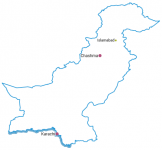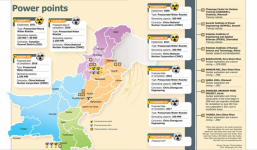- Jan 25, 2024
- 111,083
- 353
Nuclear Power Plants in Pakistan
Pakistan in 2015 produced 111 TWh of electricity, 41 TWh of this from oil, 29 from natural gas and 34 from hydro. Nuclear power makes a small contribution to total electricity production and requirements, supplying only 6.1 TWh (5.5%) of the electricity in 2015. There was no export and virtually no import, and about 17% of production is lost during transmission. Consumption in 2015 came to about 88 TWh or about 450 kWh per capita on average – although around one-quarter of the population has no access to electricity. Total installed capacity was about 25 GWe as of June 2017b, but often only about 12 GWe is operable.
Energy policy
In July 2013 the Executive Committee of the National Economic Council (ECNEC) approved about 3.5 GWe of new power projects totalling PKR 1303 billion ($12.4 billion), comprising 2200 MWe nuclear, 425 MWe gas combined cycle, and 969 MWe hydro. These are designed to reduce the high reliance on oil and to reduce power costs. All depend on Chinese support.
Electricity infrastructure is a significant part of the $51 billion China-Pakistan Economic Corridor (CPEC) projects from 2016 which will link Kashgar in China’s Xinjiang region to Pakistan’s deep-water port of Gwadar on the Arabian Sea. The CPEC includes roads and railways running much of the length of Pakistan and funded by three Chinese banks, and a 4000 MW HVDC grid development costing $1.5 billion over 2017-18. Some $33 billion of the CPEC total is for energy infrastructure, notably 10 GWe of generating capacity by 2020, mostly coal-fired, which is expected to provide 24% of the country’s power by 2020. Lignite is the main fuel envisaged, from the Thar Desert region of Sindh.
CPEC projects are a significant element in China’s Belt and Road Initiative (BRI), and are unprecedented in scale in Pakistan.
In 2005 the Energy Security Plan was adopted by the government, which called for a huge increase in generating capacity to more than 160 GWe by 2030. Significant power shortages are reported, and load shedding is common.
Nuclear policy
An expansion of nuclear capacity has long been a central element of Pakistan's energy policy.
The 2005 Energy Security Plan included the intention of lifting nuclear capacity to 8800 MWe in the long term, 900 MWe of this by 2015 and a further 1500 MWe by 2020. Projections included four further Chinese reactors of 300 MWe each and seven of 1000 MWe, all PWR. There were tentative plans for China to build two 1000 MWe PWR units at Karachi as KANUPP 2&3, but China then in 2007 deferred development of its CNP-1000 type which would have been the only one of that size able to be exported. Pakistan then turned its attention to building smaller units with higher local content. However, in 2013 China revived its 1000 MWe designs with export intent, and made overtures to Pakistan for the ACP1000 design, which became Hualong One – see below.
In August 2011 it was reported that Pakistan aimed for 8000 MWe nuclear at ten sites by 2030. PAEC has apparently selected six new sites on the basis of Pakistan Nuclear Regulatory Authority (PNRA) and International Atomic Energy Agency (IAEA) advice. These are the Qadirabad-Bulloki (QB) link canal near Qadirabad Headworks; Dera Ghazi Khan canal near Taunsa Barrage; Taunsa-Panjnad canal near Multan; Nara canal near Sukkur; Pat Feeder canal near Guddu; and Kabul River near Nowshera. Early in 2012 Pakistan Atomic Energy Commission (PAEC) said that four reactors were planned for the Taunsa-Panjnad canal near Multan in Punjab.
In January 2014 PAEC announced its intention to build five further 1100 MWe nuclear plants to meet anticipated electricity demand, and have 8.9 GWe of nuclear capacity online by 2030. "With more than 55 reactor-years of successful operating experience to its credit, the PAEC can confidently move from technology acquisition status to actually starting contributing sizable electrical energy to the system." PAEC was then quoted as saying that eight sites would be chosen for a further 32 units, four 1100 MWe units at each, so that nuclear power supplied one-quarter of the country’s electricity from 40 GWe of capacity. This evidently assumes a more than tenfold increase in electricity demand by a future date well beyond 2030.
PAEC said an initial 1100 MWe plant would be built at Muzaffargarh, on the Taunsa-Panjnad canal near Multan in southwest Punjab. It was also reported that discussions with China were under way to supply three nuclear power units for about $13 billion.
http://www.world-nuclear.org/information-library/country-profiles/countries-o-s/pakistan.aspx





